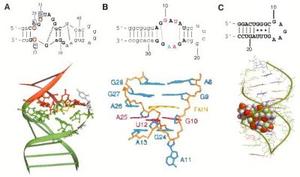DetectionUniversal detector made of DNA building blocks
Aptamers are composed of the building blocks of the genetic material DNA; scientists show that aptamers can be used quantitatively to detect and accurately examine multifaceted substances; a method for detecting such diverse substances as antibiotics, narcotics, and explosives - in effect, a universal detector — has been developed by researchers at the Max Planck Institute for Polymer Research in Mainz

Meet the aptamers // Source: uni-marburg.de
Aptamers are composed of the building blocks of the genetic material DNA; scientists show that aptamers can be used quantitatively to detect and accurately examine multifaceted substances; a method for detecting such diverse substances as antibiotics, narcotics, and explosives - in effect, a universal detector — has been developed by researchers at the Max Planck Institute for Polymer Research in Mainz. The key element of this is an atomic force microscope that can be used to subject individual molecules to a tensile test. The Mainz-based researchers are therefore focusing on aptamers, which are composed of the building blocks of the genetic material DNA. If the substance researched binds to the aptamers, the force at which they tear apart changes. In this way, the substance can not only be accurately detected at small concentrations, but can also be studied more precisely. It is therefore possible for instance to investigate how the substances researched bind to aptamers, and how great their binding strength is (Journal of the American Chemical Society, 2 February 2011).
Aptamers are a practically ideal means of detecting an extremely wide variety of chemicals. Typically, they consist of the building blocks from the hereditary materials DNA and RNA, and combine universality with specificity. They form, as it were, a box of bait with which to catch another kind of fish. Their versatility results from the innumerable possibilities of varying the sequence of the four bases of which DNA is composed. Their specificity, on the other hand, results from the physical structure that a strand of DNA with a certain base sequence adopts. This produces in the aptamer individually formed pockets into which only certain molecules fit - rather like a clay figure in its mould. “Aptamers with appropriate pockets can be found for most molecules, be they antibiotics, cocaine, TNT or proteins,” explains Rüdiger Berger of the Max Planck Institute for Polymer Research.
Among the appropriate aptamers, the researchers in Mainz are looking for one that can be split into two parts in such a way that the target molecule bound in the pocket forms a bridge between the two halves. An aptamer such as this could be found mostly in pre-selection, explains Mark Helm of the Institute of Pharmacy at the Johannes Gutenberg University Mainz, co-author of the study. For their first trials with the universal detector, the researchers selected adenosine monophosphate (AMP) as the target molecule and an aptamer
